
|

|

|
|
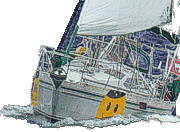
|

|
|
|
|
|
|
|
|
|
|
|
|
|
|
|
|
|
|


|
|
Some memories out of 'Ata'Ata's logbook...
|

|

|

|

|

|

|
|
2019 - 2020
|
2018
|
2017
|
2016
|
2015
|
The crossing of the South Pacific Ocean
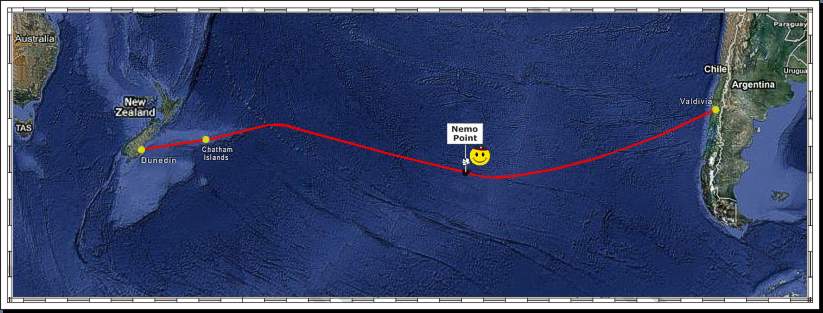
|
|
 |

|
 |
 |
|
 |
Dunedin - Chatham Islands
Nemo Point - Valdivia


To cross the largest of the oceans in the southern forties and to plant my flags at Nemo Point, was an adventure that I had been dreaming of for a long time. Why, I don't really know, apparently a man is simply so done that when he sees a mountain in front of him, he feels the need to climb it and when a sailor is on the shore of an ocean, he wants to have a look on the other side of the horizon. At a hard moment of the crossing, I wrote in my diary the famous word of Plato, reviewed in the spirit of Marcel Pagnol's César with its truculent accent of southern France:
Now that I have realized that old dream... I regret to have waited till my 70 years to do so! I can't say that it was easy, because it's still a big piece to chew, and a long one too, but I felt very comfortable and as I was approaching the South American coast, I could easily have continued the trip: no "fed up" or "finally land" feeling, just a huge happiness. And I could only be happy indeed, thinking that three months before the start I was lying at Dunedin Hospital in New Zealand, for my shoulder operation.
I immensely enjoyed sailing the first 500 miles to the Chatham Islands with my friend Allan from Dunedin, for whom it was the first offshore cruise. He is not only a tough sea kayaker, but always in mood and full of humor, just the dream crew, one of the few with whom I would undertake whatever hard crossing. From the Otago Harbour fjord, which we left in a 40 kts westerly, we had fivedays of very pleasant and varied sailing, very cold though, at the end of which we were warmly welcomed at the Chatham Islands. The fishing harbour master of Waitangi put even a buoy at our disposal , which was really welcome in this big, not very closed bay, where 'Ata'Ata seemed to be part of the strong local fishing boats family, all in raw aluminum like her.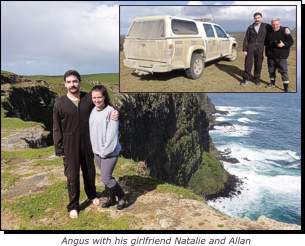 The Island's local policeman, Angus, from Wellington, had officially received from New Zealand immigration mission to control that Allan would disembark and stay in New Zealand (as the Chathams don't have a border office). But he actually had the immense kindness, together with his charming girl friend Natalie, to make us discover the whole main island, taking us for two days on an inspection tour in the police car.
The 500 inhabitants of the archipelago live from lobster and blue cod fishing, which they send by plane to Auckland at a golden price. Then they spend the money they earn in the only hotel bar of the main village of Waitangi: there they drink beers at horrendous prices, which the pretty smile of the lady boss and the nice atmosphere of the establishment easily help to swallow! But these islands, lost in that rough corner of the Pacific and which receive very few visiting boats, have mostly left me the memory of wonderfully wild landscapes, in magic light effects that only a climate of such violent and sudden changes can put on stage in such a raw nature. The Island's local policeman, Angus, from Wellington, had officially received from New Zealand immigration mission to control that Allan would disembark and stay in New Zealand (as the Chathams don't have a border office). But he actually had the immense kindness, together with his charming girl friend Natalie, to make us discover the whole main island, taking us for two days on an inspection tour in the police car.
The 500 inhabitants of the archipelago live from lobster and blue cod fishing, which they send by plane to Auckland at a golden price. Then they spend the money they earn in the only hotel bar of the main village of Waitangi: there they drink beers at horrendous prices, which the pretty smile of the lady boss and the nice atmosphere of the establishment easily help to swallow! But these islands, lost in that rough corner of the Pacific and which receive very few visiting boats, have mostly left me the memory of wonderfully wild landscapes, in magic light effects that only a climate of such violent and sudden changes can put on stage in such a raw nature.
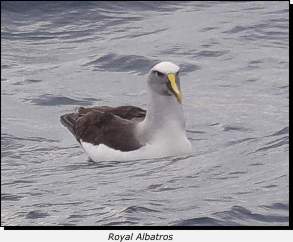 From there I sailed. now singlehanded, for a week towards ENE, up to the 40th parallel south, to avoid the strong depressions that raged at that time further south on the great circle. By 40° S - 159° W I got caught in a little SSE storm, the strongest gusts blowing only for a few hours, during which I quietly let the boat ride out of its course, to the N, the boat behaving very easily. Then I headed back towards ESE descending quite regularly in latitude until Point Nemo, which is the point on earth the furthest away from any land, a point that I had planned to reach in order to plant there the Swiss flag with the pennants of the Fadanautes of the Cercle de la Voile de Neuchâtel and of the Otago Yacht Club, of which I had received the honor to become a honorary member. I took advantage of this "conquest" of Swiss territory to bring some order in this corner of the Pacific ocean, by installing there signboards as well, which are now making there navigation much easier, by indicating s and distances of a few places in the world which are symbolic for me, in Switzerland, Italy, Germany, the USA, Polynesia and New Zealand. In 4100 meters (2242 fathoms) depth ...! :-)
From there I sailed. now singlehanded, for a week towards ENE, up to the 40th parallel south, to avoid the strong depressions that raged at that time further south on the great circle. By 40° S - 159° W I got caught in a little SSE storm, the strongest gusts blowing only for a few hours, during which I quietly let the boat ride out of its course, to the N, the boat behaving very easily. Then I headed back towards ESE descending quite regularly in latitude until Point Nemo, which is the point on earth the furthest away from any land, a point that I had planned to reach in order to plant there the Swiss flag with the pennants of the Fadanautes of the Cercle de la Voile de Neuchâtel and of the Otago Yacht Club, of which I had received the honor to become a honorary member. I took advantage of this "conquest" of Swiss territory to bring some order in this corner of the Pacific ocean, by installing there signboards as well, which are now making there navigation much easier, by indicating s and distances of a few places in the world which are symbolic for me, in Switzerland, Italy, Germany, the USA, Polynesia and New Zealand. In 4100 meters (2242 fathoms) depth ...! :-)
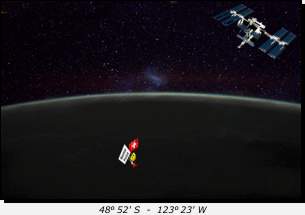
There I felt a little sorry that I did not have a HF radio, which would probably have allowed me to get in contact with the guys of the ISS space station, who were the closest human beings I had at that time. I tried on the VHF, but without any success, nor surprise. I could have asked them to give me a little time before emptying their garbage bin... since it's a matter of fact that it is in this desert corner of our globe that the space agencies of the world are dropping their out of use satellites and orbital waste of any kind!
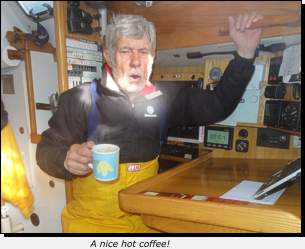 Strong westerly winds then pushed us down to 50 ° S, where I experienced the most memorable storm of my sailing life: in winds on the top of the storm scale and with waves sweeping over the deck, tearing off what they could, 'Ata'Ata prooved to be the little wonder I knew she was and I'm even more conviced after that, that a strong centerboarder is the best choice to sail in these latitudes and under these conditions . As a fact the sea is different in the deep South: the huge swell from west, which is more or less always present, is just waiting for the gales which follow one another there with a metronome regularity to generate these huge waves which bludgeon the boat, especially when they cross at a right angle a train of secondary waves left by the previous wind direction. It's impressive, I admit, to see the water cascading, as under pressure, through the interstices of the closed hatch! There are times when one feels really small, insignificant and where one can only be humbly surprised by this incredible unleashing of forces ...
Strong westerly winds then pushed us down to 50 ° S, where I experienced the most memorable storm of my sailing life: in winds on the top of the storm scale and with waves sweeping over the deck, tearing off what they could, 'Ata'Ata prooved to be the little wonder I knew she was and I'm even more conviced after that, that a strong centerboarder is the best choice to sail in these latitudes and under these conditions . As a fact the sea is different in the deep South: the huge swell from west, which is more or less always present, is just waiting for the gales which follow one another there with a metronome regularity to generate these huge waves which bludgeon the boat, especially when they cross at a right angle a train of secondary waves left by the previous wind direction. It's impressive, I admit, to see the water cascading, as under pressure, through the interstices of the closed hatch! There are times when one feels really small, insignificant and where one can only be humbly surprised by this incredible unleashing of forces ...
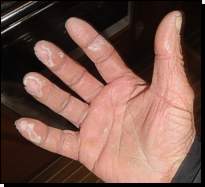 It's definitely the cold that was the biggest problem for me: around 0° C (32° F), when everything is wet, with the rain that smells of snow or hail that whips your face and hands, you can put on any layers of good clothes and keeping them on to sleep, it just quails! I drank one coffee after another, already for the sole pleasure of warming my hands, the heater not being usable when ailing in these conditions.
It's definitely the cold that was the biggest problem for me: around 0° C (32° F), when everything is wet, with the rain that smells of snow or hail that whips your face and hands, you can put on any layers of good clothes and keeping them on to sleep, it just quails! I drank one coffee after another, already for the sole pleasure of warming my hands, the heater not being usable when ailing in these conditions.
I had a bit of luck too, well, a big bit, I should say: shortly after the mid-road and after the strongest storm of the crossing, a lower shroud broke, just because of a simple U-shaped stainless steel plate that had crystallized (a well known phenomenon, but which in practice I experienced live for the first time in 50 years of sailing). I managed to repair and finish "smoothly" without losing the mast, sacrifying a little speed, which did not matter at all (I probably could have saved some 2 days if I would have been able to sail at full power).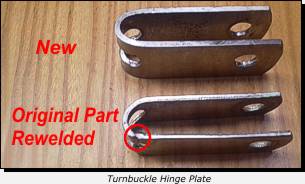 It is psychologically very unpleasant, 2000 nautical miles away from any land, to suddenly see a shroud swingiing around in the air, knowing that there are five other identical bits holding the mast with the same risk of breakage: too thin material, weakened by the print left by the claws of the folding tool! The large reserve of rope I have aboard was very useful to repair and reinforce the whole rig, particularly the 200 meters (650 ft) of Dyneema of Ø 8 and 10 mm (5/16" and 3/8"). Anyway it work and in the vice of the marina's workshop on arrival I could make new bits of the appropriate material thickness. It is psychologically very unpleasant, 2000 nautical miles away from any land, to suddenly see a shroud swingiing around in the air, knowing that there are five other identical bits holding the mast with the same risk of breakage: too thin material, weakened by the print left by the claws of the folding tool! The large reserve of rope I have aboard was very useful to repair and reinforce the whole rig, particularly the 200 meters (650 ft) of Dyneema of Ø 8 and 10 mm (5/16" and 3/8"). Anyway it work and in the vice of the marina's workshop on arrival I could make new bits of the appropriate material thickness.
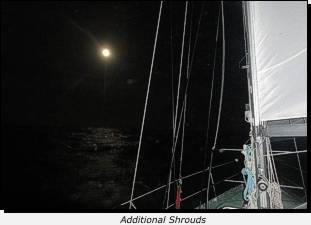 I also had to make a new rudder blade Windpilot, the original aluminum profile having broken like matches, torn from the back to the front, i.e. in the direction of sailing. Unless a big fish took that thing for a toothpick, it's the banging of the powerful waves from benind which broke that rudder blade, an elegant but of inadequately designed part: being locked by a nylon screw , it should not be retractable backwards only, but forwards too. With my small aboard rechargeable drill, I was able to make quite a strong spare blade , sacrifying the plywood bench my inflatable tender, reinforcing it with stainless steel cheeks. This emergency blade is still working today... as efficiently as the original one.
I also had to make a new rudder blade Windpilot, the original aluminum profile having broken like matches, torn from the back to the front, i.e. in the direction of sailing. Unless a big fish took that thing for a toothpick, it's the banging of the powerful waves from benind which broke that rudder blade, an elegant but of inadequately designed part: being locked by a nylon screw , it should not be retractable backwards only, but forwards too. With my small aboard rechargeable drill, I was able to make quite a strong spare blade , sacrifying the plywood bench my inflatable tender, reinforcing it with stainless steel cheeks. This emergency blade is still working today... as efficiently as the original one.
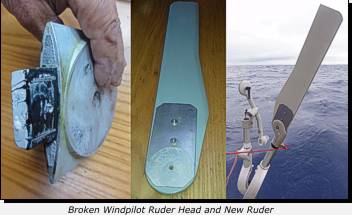 A thousand nautical miles from the Chilean coast, at 45 ° S I sailed for almost two days in a cold and wet fog, with visibility reduced to less than half a mile. It was magical to sail in this cotton that reminded me of my old times sailings in the English Channel and the North Sea, but far from everything in the middle of nowhere. Fortunately there was enough wind from the south to progress regularly. And 200 nautical miles from the coast I had the first and only encounter of the whole trip, when a big Chilean fishing ship crossed my route in front of us.
A thousand nautical miles from the Chilean coast, at 45 ° S I sailed for almost two days in a cold and wet fog, with visibility reduced to less than half a mile. It was magical to sail in this cotton that reminded me of my old times sailings in the English Channel and the North Sea, but far from everything in the middle of nowhere. Fortunately there was enough wind from the south to progress regularly. And 200 nautical miles from the coast I had the first and only encounter of the whole trip, when a big Chilean fishing ship crossed my route in front of us.
After 45 days at sea and 4735 nautical miles, I was warm heartedly welcomed at the Club de Yates de Valdivia, in their small marina La Estancilla of Rio Valdivia, halfway between the city and the ocean. After all the friends I had found in New Zealand, the Chileans are wonderful kind people too, including all the guys of the Navy, Customs, Immigration, Ministry of Agriculture and MRCC (Maritime Rescue): they do their job very seriously but kindly too and without any complication and it is the only country in South America to have set up an offshore rescue organization operating on such a huge surface, since they go from Antarctica to the Tropics and to Easter Island in the west). Hats off!
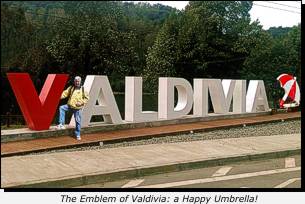 It was a while since I had last used my spanish and it was very useful to me, because in fact I hardly had a moment for me after my arrival: all the time invited on the other boats or receiving sailors who came to welcome and congratulate me for that beautiful singlehanded crossing, often with a bottle of wine or some other gift! Just like that; people are great and the area, in a meander of Chile's only navigable river, is absolutely delightful, drowned in all shades of green. In return, of course, as the inhabitants of the region proudly say, Valdivia is located in the rainiest zone of Chile! And in fact, on average there's a lot of rain, although these first summer days are beautiful. It does not leave indifferent to think that this "Region de los Rios", the idyllic region of the rivers, of which Valdivia is the capital, was completely remodeled in 1960 by the strongest earthquake ever recorded on our planet: 9 , 5 of magnitude, with unimaginable damages and thousands of deaths in Chile and all over the vastness of the Pacific Ocean!
It was a while since I had last used my spanish and it was very useful to me, because in fact I hardly had a moment for me after my arrival: all the time invited on the other boats or receiving sailors who came to welcome and congratulate me for that beautiful singlehanded crossing, often with a bottle of wine or some other gift! Just like that; people are great and the area, in a meander of Chile's only navigable river, is absolutely delightful, drowned in all shades of green. In return, of course, as the inhabitants of the region proudly say, Valdivia is located in the rainiest zone of Chile! And in fact, on average there's a lot of rain, although these first summer days are beautiful. It does not leave indifferent to think that this "Region de los Rios", the idyllic region of the rivers, of which Valdivia is the capital, was completely remodeled in 1960 by the strongest earthquake ever recorded on our planet: 9 , 5 of magnitude, with unimaginable damages and thousands of deaths in Chile and all over the vastness of the Pacific Ocean!
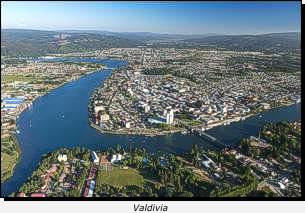 From the marina there is a bus every 20 minutes which drives on about ten kilometers along the river to the pretty city of Valdivia. With its 130,000 inhabitants and the prestigious Universidad Austral de Chile, among other universities, it is very similar to Dunedin in New Zealand, which is about the the same size and also lives around its important university in the south of the country. And the contrast is really striking from one shore to the other of the Pacific ocean, 10,000 kilometers (more than 6000 miles) apart, between both these friendly and welcoming cities, but with the opposition of the quiet, organized and clean atmosphere of the kiwi city of northern temperament and the meny colours, sounds and activities of the city of Latin America. What a wonderful privilege to have been able to experience this fascinating wealth of our world with the simple force of the wind in the sails of my little boat, which gave me the time to take the real measure of things!
From the marina there is a bus every 20 minutes which drives on about ten kilometers along the river to the pretty city of Valdivia. With its 130,000 inhabitants and the prestigious Universidad Austral de Chile, among other universities, it is very similar to Dunedin in New Zealand, which is about the the same size and also lives around its important university in the south of the country. And the contrast is really striking from one shore to the other of the Pacific ocean, 10,000 kilometers (more than 6000 miles) apart, between both these friendly and welcoming cities, but with the opposition of the quiet, organized and clean atmosphere of the kiwi city of northern temperament and the meny colours, sounds and activities of the city of Latin America. What a wonderful privilege to have been able to experience this fascinating wealth of our world with the simple force of the wind in the sails of my little boat, which gave me the time to take the real measure of things!
|
|
|
 |
 |

|
 |
|
|
|
|
|
|